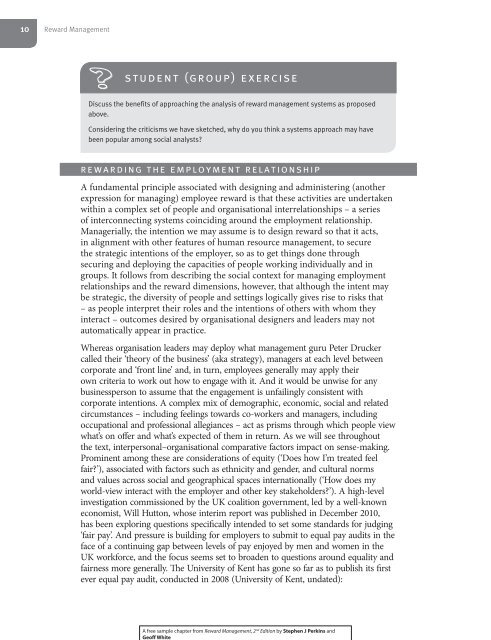Introducing the Reward Management System - CIPD
Introducing the Reward Management System - CIPD
Introducing the Reward Management System - CIPD
Create successful ePaper yourself
Turn your PDF publications into a flip-book with our unique Google optimized e-Paper software.
10<br />
<strong>Reward</strong> <strong>Management</strong><br />
student (group) exercise<br />
Discuss <strong>the</strong> benefits of approaching <strong>the</strong> analysis of reward management systems as proposed<br />
above.<br />
Considering <strong>the</strong> criticisms we have sketched, why do you think a systems approach may have<br />
been popular among social analysts?<br />
rewarding <strong>the</strong> employment relationship<br />
A fundamental principle associated with designing and administering (ano<strong>the</strong>r<br />
expression for managing) employee reward is that <strong>the</strong>se activities are undertaken<br />
within a complex set of people and organisational interrelationships – a series<br />
of interconnecting systems coinciding around <strong>the</strong> employment relationship.<br />
Managerially, <strong>the</strong> intention we may assume is to design reward so that it acts,<br />
in alignment with o<strong>the</strong>r features of human resource management, to secure<br />
<strong>the</strong> strategic intentions of <strong>the</strong> employer, so as to get things done through<br />
securing and deploying <strong>the</strong> capacities of people working individually and in<br />
groups. It follows from describing <strong>the</strong> social context for managing employment<br />
relationships and <strong>the</strong> reward dimensions, however, that although <strong>the</strong> intent may<br />
be strategic, <strong>the</strong> diversity of people and settings logically gives rise to risks that<br />
– as people interpret <strong>the</strong>ir roles and <strong>the</strong> intentions of o<strong>the</strong>rs with whom <strong>the</strong>y<br />
interact – outcomes desired by organisational designers and leaders may not<br />
automatically appear in practice.<br />
Whereas organisation leaders may deploy what management guru Peter Drucker<br />
called <strong>the</strong>ir ‘<strong>the</strong>ory of <strong>the</strong> business’ (aka strategy), managers at each level between<br />
corporate and ‘front line’ and, in turn, employees generally may apply <strong>the</strong>ir<br />
own criteria to work out how to engage with it. And it would be unwise for any<br />
businessperson to assume that <strong>the</strong> engagement is unfailingly consistent with<br />
corporate intentions. A complex mix of demographic, economic, social and related<br />
circumstances – including feelings towards co-workers and managers, including<br />
occupational and professional allegiances – act as prisms through which people view<br />
what’s on offer and what’s expected of <strong>the</strong>m in return. As we will see throughout<br />
<strong>the</strong> text, interpersonal–organisational comparative factors impact on sense-making.<br />
Prominent among <strong>the</strong>se are considerations of equity (‘Does how I’m treated feel<br />
fair?’), associated with factors such as ethnicity and gender, and cultural norms<br />
and values across social and geographical spaces internationally (‘How does my<br />
world-view interact with <strong>the</strong> employer and o<strong>the</strong>r key stakeholders?’). A high-level<br />
investigation commissioned by <strong>the</strong> UK coalition government, led by a well-known<br />
economist, Will Hutton, whose interim report was published in December 2010,<br />
has been exploring questions specifically intended to set some standards for judging<br />
‘fair pay’. And pressure is building for employers to submit to equal pay audits in <strong>the</strong><br />
face of a continuing gap between levels of pay enjoyed by men and women in <strong>the</strong><br />
UK workforce, and <strong>the</strong> focus seems set to broaden to questions around equality and<br />
fairness more generally. The University of Kent has gone so far as to publish its first<br />
ever equal pay audit, conducted in 2008 (University of Kent, undated):<br />
A free sample chapter from <strong>Reward</strong> <strong>Management</strong>, 2 nd Edition by Stephen J Perkins and<br />
Geoff White<br />
Published by <strong>the</strong> <strong>CIPD</strong>.<br />
Copyright © <strong>CIPD</strong> 2011<br />
All rights reserved; no part of this excerpt may be reproduced, stored in a retrieval system,<br />
or transmitted in any form or by any means, electronic, mechanical, photocopying, recording,<br />
or o<strong>the</strong>rwise without <strong>the</strong> prior written permission of <strong>the</strong> Publishers or a licence permitting<br />
restricted copying in <strong>the</strong> United Kingdom issued by <strong>the</strong> Copyright Licensing Agency.<br />
If you would like to purchase this book please visit www.cipd.co.uk/bookstore.

















